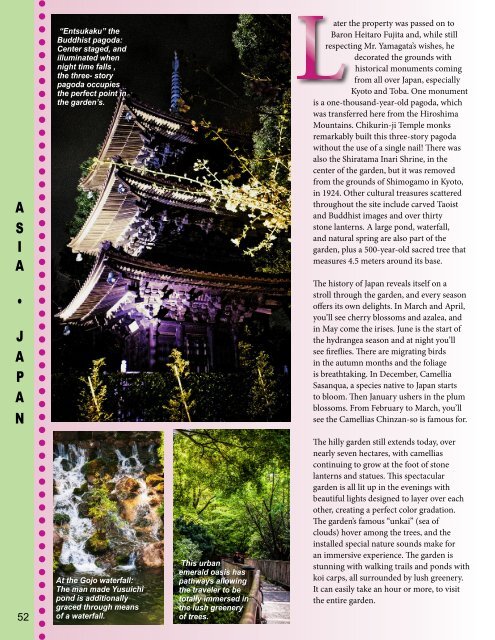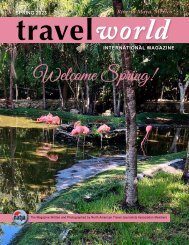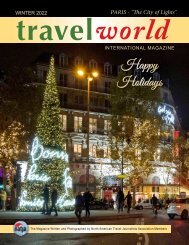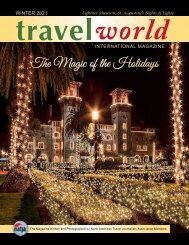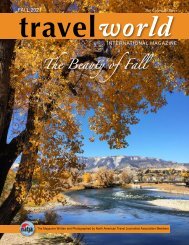TravelWorld International Magazine, Spring 2022 - Spring into Travel
The magazine written and photographed by members of the North American Travel Journalists Association.
The magazine written and photographed by members of the North American Travel Journalists Association.
You also want an ePaper? Increase the reach of your titles
YUMPU automatically turns print PDFs into web optimized ePapers that Google loves.
N<br />
O<br />
RA<br />
TS<br />
I<br />
H<br />
A<br />
•<br />
A<br />
MJ<br />
A<br />
EP<br />
RA<br />
IN<br />
C<br />
A<br />
52<br />
“Entsukaku” the<br />
Buddhist pagoda:<br />
Center staged, and<br />
illuminated when<br />
night time falls ,<br />
the three- story<br />
pagoda occupies<br />
the perfect point in<br />
the garden’s.<br />
At the Gojo waterfall:<br />
The man made Yusuichi<br />
pond is additionally<br />
graced through means<br />
of a waterfall.<br />
This urban<br />
emerald oasis has<br />
pathways allowing<br />
the traveler to be<br />
totally immersed in<br />
the lush greenery<br />
of trees.<br />
ater the property was passed on to<br />
Baron Heitaro Fujita and, while still<br />
respecting Mr. Yamagata’s wishes, he<br />
decorated the grounds with<br />
historical monuments coming<br />
from all over Japan, especially<br />
Kyoto and Toba. One monument<br />
is a one-thousand-year-old pagoda, which<br />
was transferred here from the Hiroshima<br />
Mountains. Chikurin-ji Temple monks<br />
remarkably built this three-story pagoda<br />
without the use of a single nail! There was<br />
also the Shiratama Inari Shrine, in the<br />
center of the garden, but it was removed<br />
from the grounds of Shimogamo in Kyoto,<br />
in 1924. Other cultural treasures scattered<br />
throughout the site include carved Taoist<br />
and Buddhist images and over thirty<br />
stone lanterns. A large pond, waterfall,<br />
and natural spring are also part of the<br />
garden, plus a 500-year-old sacred tree that<br />
measures 4.5 meters around its base.<br />
The history of Japan reveals itself on a<br />
stroll through the garden, and every season<br />
offers its own delights. In March and April,<br />
you’ll see cherry blossoms and azalea, and<br />
in May come the irises. June is the start of<br />
the hydrangea season and at night you’ll<br />
see fireflies. There are migrating birds<br />
in the autumn months and the foliage<br />
is breathtaking. In December, Camellia<br />
Sasanqua, a species native to Japan starts<br />
to bloom. Then January ushers in the plum<br />
blossoms. From February to March, you’ll<br />
see the Camellias Chinzan-so is famous for.<br />
The hilly garden still extends today, over<br />
nearly seven hectares, with camellias<br />
continuing to grow at the foot of stone<br />
lanterns and statues. This spectacular<br />
garden is all lit up in the evenings with<br />
beautiful lights designed to layer over each<br />
other, creating a perfect color gradation.<br />
The garden’s famous “unkai” (sea of<br />
clouds) hover among the trees, and the<br />
installed special nature sounds make for<br />
an immersive experience. The garden is<br />
stunning with walking trails and ponds with<br />
koi carps, all surrounded by lush greenery.<br />
It can easily take an hour or more, to visit<br />
the entire garden.<br />
he garden has many<br />
Japanese traditional<br />
features, among them a<br />
red bridge (Benkei bridge), a<br />
feature that was very popular<br />
during the Edo period. The<br />
Chinzan-so monument,<br />
inscribed with writings by Yamagata,<br />
is evidence of his great fondness<br />
for the place. Dabbling as he did in<br />
composing waka poems, Yamagata<br />
had a cultural side evidenced by the<br />
passion he devoted to create gardens.<br />
Though the garden was destroyed<br />
during World War II, reconstruction<br />
soon began in 1948, under the<br />
direction of Ogawa Eiichi, whose<br />
vision of “building a green oasis in<br />
Tokyo” included the transportation<br />
of more than ten thousand trees. A<br />
festive party on November 11th, 1952,<br />
marked the grand opening of the<br />
Chinzan-so as a garden restaurant. It<br />
proudly celebrates its 70th anniversary,<br />
this year.<br />
Like most Japanese gardens, the<br />
Chinzan-so garden can be enjoyed in<br />
every season, but the most spectacular<br />
times to visit are in spring for the<br />
cherry blossoms and in fall, for<br />
the autumn leaves. The settings of<br />
this garden, with the quaint pond,<br />
stunning pagoda, waterfall, lanterns<br />
and images of Taoism and Buddhism,<br />
all add to the exquisite beauty of this<br />
lovely garden. It is clear that Old<br />
Japan survives in this garden that is in<br />
modern Tokyo, for as you enter it you<br />
are transported back <strong>into</strong> a completely<br />
different world. It is a world that<br />
stays true to its former name and<br />
original creator with its large variety<br />
of camellias from throughout Japan.<br />
The recent addition, at certain times<br />
of the day, of the astonishing release<br />
of artificial fog creates a mystical,<br />
magical, and mysterious feel to the<br />
place, a perfect illusion, giving it a<br />
dreamy look that is absolute poetry in<br />
the making!<br />
The holy image<br />
of the Kanzeon<br />
goddess is<br />
enshrined<br />
in the three<br />
storied Buddhist<br />
pagoda and<br />
destined to<br />
protect the site.<br />
All lit up at night,<br />
“Fukuroku-ju”<br />
god of fortune,<br />
wealth and<br />
longevity is<br />
however one of<br />
the seven gods<br />
scattered around<br />
the garden’s<br />
paths.<br />
Closest to the<br />
Kanda River, this<br />
cautiously designed<br />
lower gate to the<br />
Chinzan-so garden<br />
leads to the Ryotei.<br />
Evening Cherry<br />
blossoms viewing in<br />
Chinzan-so garden.<br />
A<br />
S<br />
I<br />
A<br />
•<br />
J<br />
A<br />
P<br />
A<br />
N<br />
53


